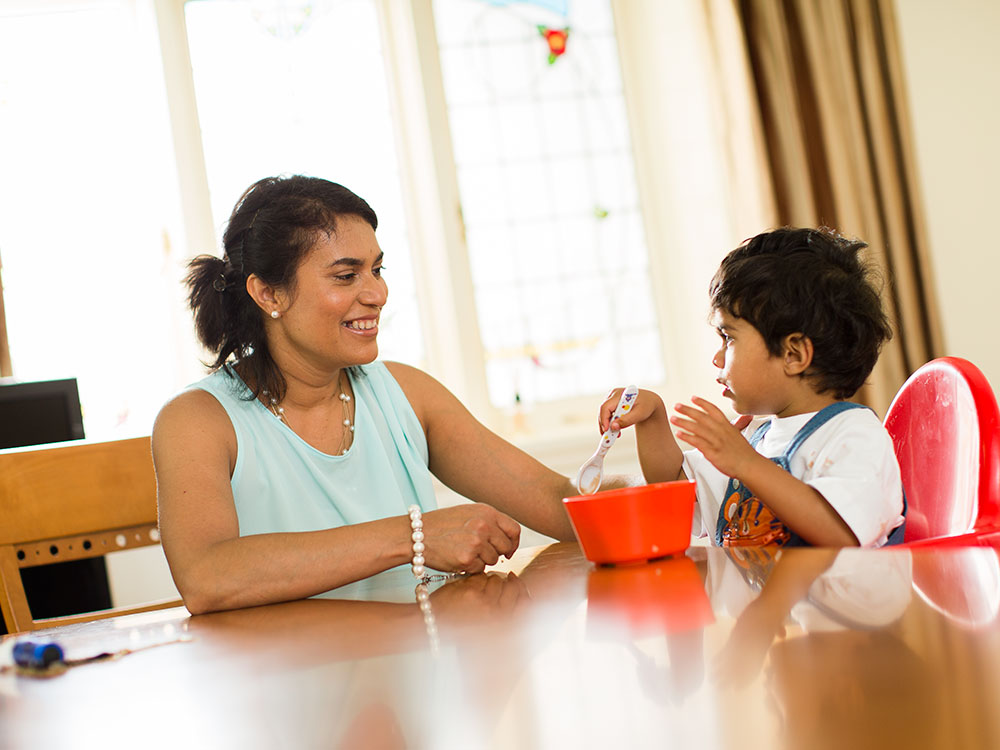Introduction: Why Acknowledging Toddlers Matters
Toddlerhood is a flurry of emotional inquiry, fast development, and growing communication. Our interactions with our children greatly influence their sense of self and perspective on the world at this vital period. It’s about our manner of saying as much as what we say. A basic human need, feeling seen and heard is also the foundation of developing safe bonds and emotional intelligence for young children. Many times, we minimize the complexity of their inner life by discounting their attempts at communication or dissatisfaction. But by deliberately selecting our words, we may affirm their experiences, boost their confidence, and provide a secure environment where they could express themselves. The top 10 words that make infants visible and heard will be explored in this blog article together with useful tips and ideas on how these straightforward gestures could change our interactions and deepen our relationships. – The Top 10 Phrases

1. “I see you’re trying really hard.”
This sentence honors a toddler’s effort instead of emphasizing just the result. Toddlers are always learning and exploring, and their activities can include great challenges. We honor their diligence and inspire them to keep on by seeing their tenacity. When a child is laboring to create a tower of blocks, for instance, try saying, “I see you’re trying really hard to make it tall,” rather than, “Let me do it.” This little change in vocabulary expresses sympathy and encouragement, therefore promoting a development attitude. Furthermore significant is the fact that this sentence applies to many circumstances, from learning a new ability to controlling challenging feelings. Saying, “I see you’re trying really hard to calm down,” to a toddler when they are agitated will enable them to feel supported and understood. Toddlers will find great help in this sentence in feeling acknowledged and heard.
2. “Tell me more about it.”
This sentence helps young children to express their ideas and emotions, therefore improving their communication abilities and showing real interest in their experiences. Toddlers may show themselves through gestures or broken utterances, so it might be easy to fill in the voids for them. But by asking them to explain, we enable them to express their ideas in their own terms. If a toddler says, “Sad,” for instance, rather than asking, “Why are you sad?” try answering, “Tell me more about it.” This open-ended inquiry lets individuals really express their emotions, therefore helping us to better grasp their viewpoint. As infants learn to create cogent stories and communicate difficult emotions, this method also helps them grow in language and storytelling ability. Toddlers who feel seen and heard commonly respond to open-ended inquiries meant to foster connection and communication.
3. “It’s okay to feel [emotion].”
Emotional growth of a child depends on validating their feelings. From happiness and excitement to frustration and wrath, toddlers go through a vast spectrum of emotions. We educate our children that all emotions are legitimate and that they are not alone in their experiences by appreciating and understanding their sentiments. When a toddler is unhappy about not obtaining a toy, for instance, consider stating, “It’s okay to feel sad that you can’t have the toy right now,” rather than “don’t be sad.” This sentence helps kids realize that it’s OK to communicate their emotions and enables them to normalize them. It also creates the avenue for more conversation, which will enable us to guide them in managing their emotions. Making your toddler heard validates their feelings.
4. “I understand that’s frustrating.”
Frustration is a common emotion for toddlers, as they encounter numerous obstacles in their daily lives. Acknowledging their frustration demonstrates empathy and helps them feel understood. Instead of dismissing their frustration or telling them to “calm down,” try saying, “I understand that’s frustrating.” This phrase validates their feelings and helps them feel less alone in their struggle. It also opens the door for problem-solving, as we can work together to find solutions or alternatives. For example, if a toddler is frustrated because they can’t reach a toy on a shelf, saying, “I understand that’s frustrating. Let’s find a step stool so you can reach it.” This phrase shows empathy and offers a practical solution.
5. “You did it!”
Celebrating a toddler’s achievements—no matter how minor—helps them to maintain confidence and motivates them to keep trying. Positive reinforcement is what toddlers love, hence praising their successes helps them develop self-efficacy. When a young child finishes a puzzle or creates a tower, for instance, show your excitement by stating, “You did it!” This one sentence makes your pride clear and supports their sense of achievement. Your compliments should also be precise, stressing the particular abilities or efforts that helped them succeed. Said, “You did it! More effective than a broad “Good job” is your putting all the jigsaw pieces together. One of the words that helps toddlers feel visible is this one.
6. “Let’s do it together.”
Toddlers’ activities typically need for help and cooperation. Offering to work together shows our support and generates chances for learning and bonding. When toddlers are having trouble with a task or feeling overwhelmed, this sentence especially helps. If a child finds it difficult to put on their shoes, for instance, instead of intervening, try suggesting, “Let’s do it together.” This group method lets kids feel connected and encouraged while learning and honing fresh abilities. Furthermore encouraging vital social skills, it promotes cooperation and teamwork.
7. “You’re safe here with me.”
A toddler’s mental health depends on a feeling of security. Particularly in strange circumstances or while their parents are away, toddlers typically suffer from worry and terror. Assuring them of their protection helps them to feel stable and comfortable. When a young child is afraid of a loud noise or a strange surroundings, for instance, try saying, “You’re safe here with me.” This sentence communicates your presence and protection, thereby guiding their sense of security and support. To support your confidence, it’s also beneficial to offer physical comfort—a hug or a light touch.
8. “Thank you for helping.”
Celebrating a toddler’s contributions—no matter how small—helps them to feel responsible and useful. Toddlers like helping with housework or supporting their caregivers; expressing thanks for their efforts helps them to keep on participating. When a toddler helps set the table or tidy toys, for instance, say, “Thank you for helping.” This line expresses your gratitude and supports their helping nature. It also emphasizes for them the need of helping the family and the society.
9. “I love spending time with you.”
Showing a child love and thanks for their company helps you to enhance your relationship and their sense of belonging. Toddlers benefit from positive attention and affection; showing your love and appreciation of their company can enable them to feel important and loved. Say, for instance, “I love spending time with you,” during play or bedtime. This sentence supports your relationship and shows your devotion. Expressing your gratitude for particular traits or behaviors—such as their ingenuity or kindness—helps also.
10. “You’re a good friend.”
Young children are starting to build connections and acquire social skills. Acknowledging their good social contacts helps them to feel more like they belong and motivates them to keep creating solid ties. When a young child exchanges a toy or soothes a buddy, for instance, say, “You’re a good friend.” This sentence supports their good social conduct and expresses your gratitude for their compassion. It clarifies for them also the value of friendship and empathy.

Practical Applications and Real-Life Scenarios
Understanding the theory behind these phrases is one thing; applying them in the heat of the moment is another. Here are some real-life scenarios and how to use these phrases effectively:
- Scenario 1: Tantrum in the Grocery Store:
- Toddler wants a candy bar and throws a tantrum when told no.
- Instead of: “Stop crying! You’re embarrassing me.”
- Try: “I understand that’s frustrating. You really wanted that candy. It’s okay to feel upset. Let’s take some deep breaths together.” (Combines phrases #3 and #4).
- Scenario 2: Difficulty with a Puzzle:
- Toddler is struggling to fit pieces together and gets discouraged.
- Instead of: “Just let me do it.”
- Try: “I see you’re trying really hard. Let’s do it together. Where do you think this piece goes?” (Combines phrases #1 and #6).
- Scenario 3: Sharing with a Friend:
- Toddler shares a toy with a playmate.
- Instead of: “Good job.”
- Try: “You’re a good friend. Thank you for sharing. That made your friend very happy.” (Combines phrases #8 and #10).
- Scenario 4: Bedtime Fears:
- Toddler is afraid of the dark.
- Instead of: “There’s nothing to be afraid of.”
- Try: “You’re safe here with me. I’m right here. Tell me more about what you’re feeling.” (Combines phrases #2 and #7).
- Scenario 5: Building a tower
- Toddler builds a tower and it is tall.
- Instead of: “Good job”
- Try: “You did it! You made that tower so tall!” (Phrase #5)
The Long-Term Impact of Empathetic Communication
Using these words has advantages well beyond casual conversations. Regularly making toddlers seen and heard prepares them for:
- Toddlers who experience understanding are more suited to control their emotions.
- Valuing their experiences helps one to develop confidence and a good self-image.
- Enhanced Communication Skills: Encouragement of their expression of themselves promotes their language growth.
- Secure Attachment: Meeting their needs fosters confidence and security.
- Toddlers who show empathy are more likely to grow sympathetic themselves.
Overcoming Common Challenges
Using these communication techniques often presents difficulties for parents and other caretakers. These ideas help one to overcome typical challenges:
- Changing established communication patterns requires time and practice; patience and consistency are thus vital. Show your child and yourself patience.
- Self-regulate your own feelings before reacting to those of your child. Breathe deeply or, if necessary, move away.
- Mindful Listening: Watch for nonverbal as well as vocal signals from your youngster. Clear away distractions and offer them your whole focus.
- Every toddler is different and should be adapted to their own need. Craft your approach to fit their developmental level and personality.
- Ask for help: Don’t hesitate to contact professionals or parenting materials for direction.
The Science Behind Connection
These words have significance based on attachment theory and brain development science. Reacting to young children with empathy and affirmation helps us to engage the areas of their brain in charge of social connection and emotional control. This starts a positive feedback loop that reinforces good communication styles and deepens the parent-child relationship.
- Attachment Theory: Emphasizes the need of sensitive and responsive caring in developing safe attachments.
- Neuroplasticity: Emphasizes how experiences—including language and interaction—allow the brain to adapt and grow.
- Mirror Neurons: Says that by reflecting the experiences of others, we could learn and grasp emotions.
Building a Language of Connection
Phrases that help children feel seen and heard are ultimately more than simply words; they are instruments for developing connection, emotional intelligence, and positive relationships. These words will help us to establish a caring and encouraging atmosphere in which young children feel appreciated, understood, and empowered by means of our everyday contacts.
Recall, every interaction presents a chance for connection. Our tiny ones’ life will be much changed if we choose our words deliberately.
Expanding the Language: Variations and Nuances
While the core 10 phrases are powerful, it’s essential to understand that language is fluid and adaptable. Tailoring these phrases to your child’s specific personality and the situation at hand can make them even more effective.
- Personalizing the Phrases:
- Instead of a generic “I love spending time with you,” try “I love how silly you are when we play peek-a-boo!” or “I really love when you read books with me.” This adds a specific layer of appreciation.
- For “You did it!” you could say, “You did it all by yourself! I saw how carefully you worked.”
- Using Non-Verbal Communication:
- Words are only part of the equation. Tone of voice, facial expressions, and body language are equally important. A gentle tone and warm eye contact can amplify the impact of your words.
- A hug or a gentle touch while saying “You’re safe here with me” can provide extra reassurance.
- Adapting to Different Ages:
- While these phrases are primarily aimed at toddlers, they can be adapted for older children as well. For example, “I understand that’s frustrating” remains relevant for a school-aged child struggling with homework.
- “Tell me more about it” can be changed to “I’m interested in what you think about this” when talking to older children.
- Incorporating Play:
- Play is a powerful tool for communication. Use these phrases during play to reinforce their meaning. For example, while playing with dolls, you could say, “You’re a good friend to your doll.”
- while playing with building blocks, you can say “I see you’re trying really hard to make a tall tower.”
- Being Authentic:
- Children can sense insincerity. Make sure your words and actions align. Genuine empathy and compassion are essential for building trust.

Final Thoughts: The Power of Connection
It’s easy to forget in the daily grind the value of our connections with young children. But we can foster a loving environment where they flourish by deliberately selecting our words and giving connection first priority. Not only a collection of words, the top 10 phrases that help toddlers feel seen and heard are tools for establishing bridges, encouraging emotional intelligence, and fortifying the relationships that mold our children’s life.
Recall that every contact presents a chance for change. Toddlers may be guided to negotiate the world with confidence and compassion by our sympathetic listening, validation of their emotions, and celebration of their efforts. These words form the basis of a loving and encouraging relationship, therefore guiding good emotional growth and lifetime connection.
Regular application of these communication techniques helps us not only make our kids seen and heard but also foster a closer awareness of our own humanity. Empathy and validation are gifts that enhance the giver as well as the receiver and help to create a more caring and connected society.
References:
- Harvard University Center on the Developing Child: https://developingchild.harvard.edu/
- Zero to Three: National Center for Infants, Toddlers, and Families: https://www.zerotothree.org/
- American Academy of Pediatrics: https://www.aap.org/






